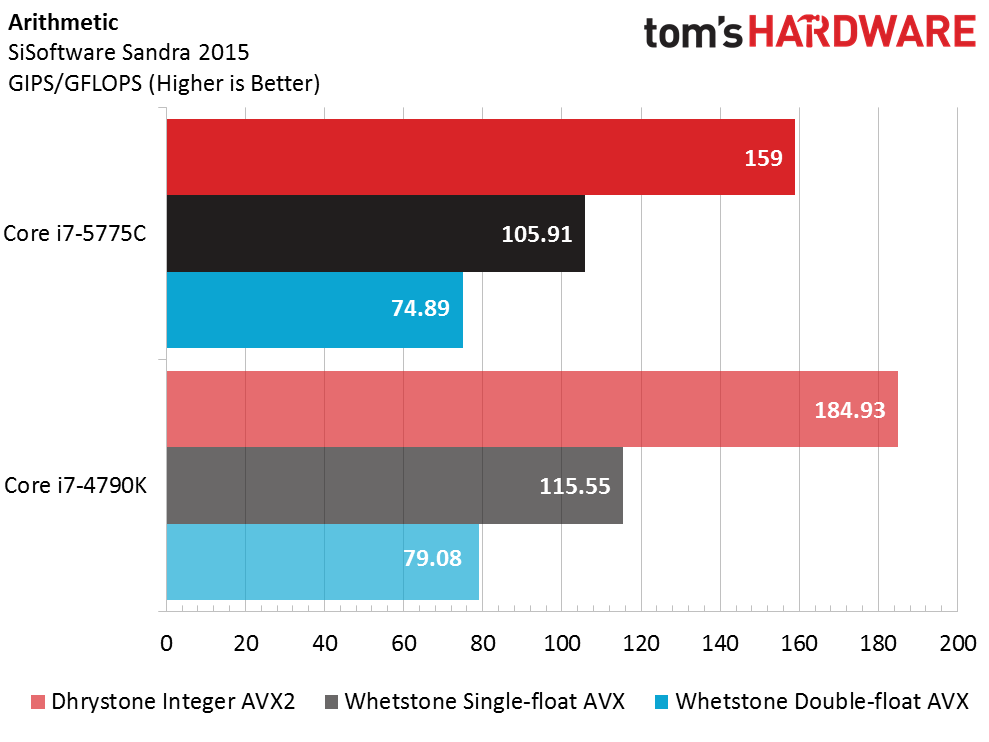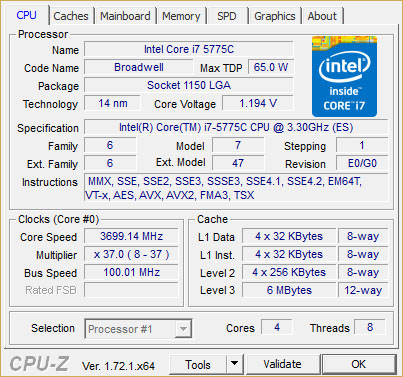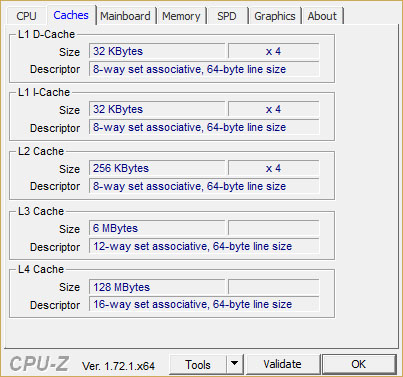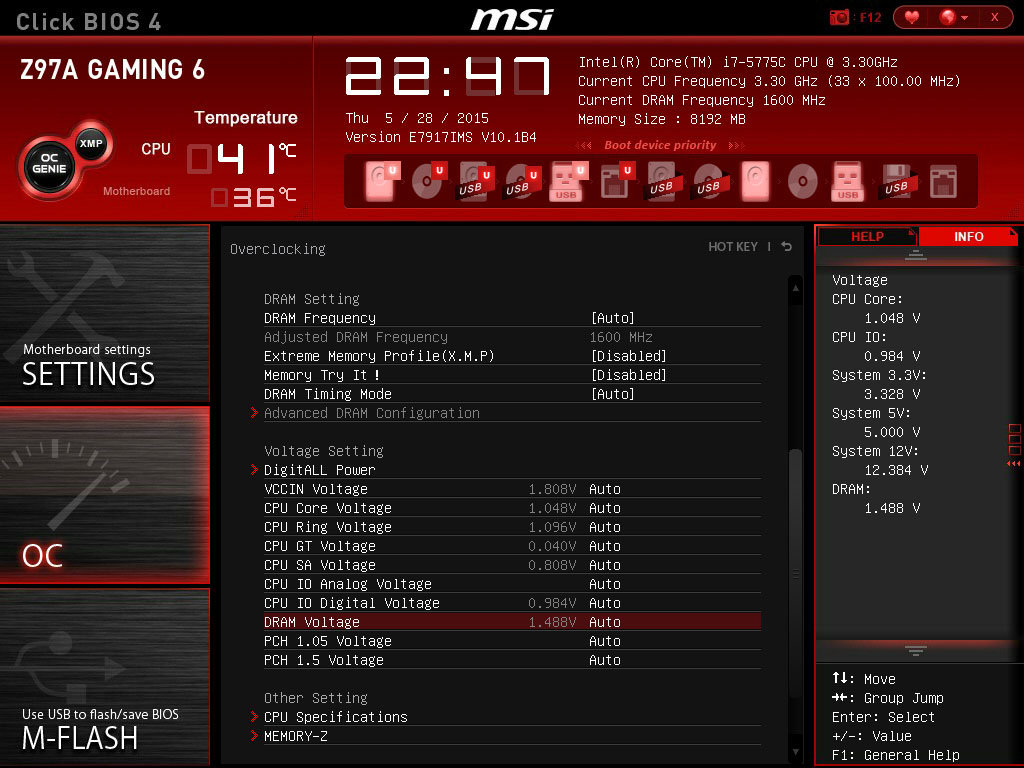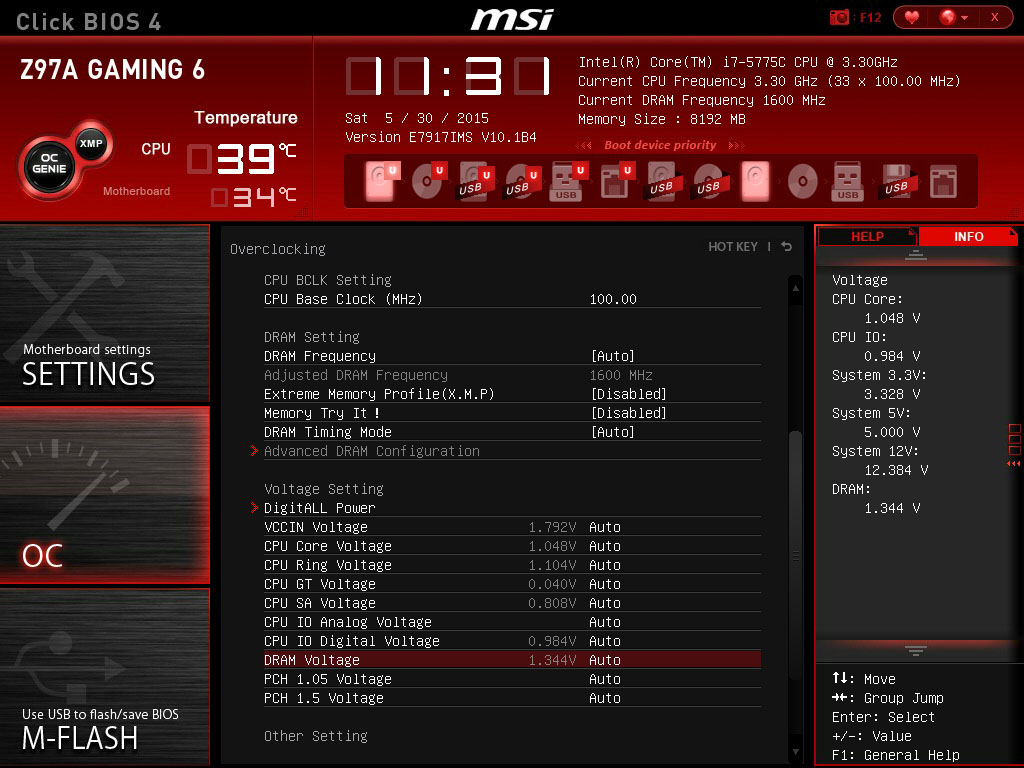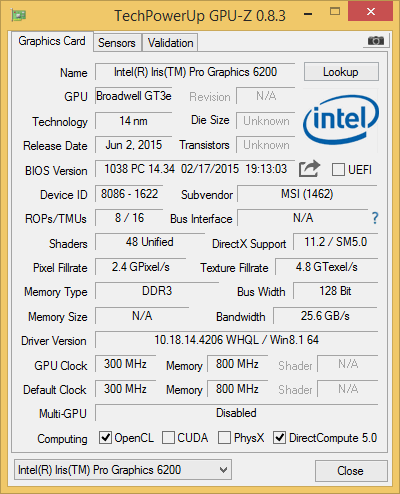Broadwell: Intel Core i7-5775C And i5-5675C Review
Introduction
The time has finally come for Intel to introduce its socketed Broadwell processors. They’re fabulously late, and you’re probably not going to want to buy them, what with Intel’s Skylake architecture close at hand. But they’re frankly fantastic little CPUs, particularly if you’re a history buff.
What do I mean by that? Well, exactly two years ago, the company was unveiling its Haswell-based desktop processors and Tom’s Hardware’s sentiment was captured somewhat succinctly, I think, by the title of our launch story, The Core i7-4770K Review: Haswell Is Faster; Desktop Enthusiasts Yawn.
Prior to that piece’s publication, I had just spent a couple of days with Intel in Santa Clara learning about its Haswell architecture. Most of the emphasis was (understandably) focused on the mobile effort. We talked about optimizations for power, the Iris Pro Graphics 5200 that’d propel high-end notebook performance forward without a discrete GPU and increased attention on x86 architectures that’d scale down to tablet form factors. It was all well and good. What we saw was exciting, and what we were promised pointed to a future filled with performance-enhancing integration driven by efficiency.
There was just one thing missing, though. Desktop users didn’t get the most exciting goodies. The highest-end socketed CPUs were stuck with decidedly mainstream HD Graphics 4600. Worse, perhaps, the company eliminated the “limited overclocking” previously available on non-K-series models.
What reason did we have to upgrade, then? A little more IPC throughput? Meh. We were underwhelmed, and not particularly subtle about letting Intel know.
Broadwell For Desktop: A Change In The Air?
Massive though the company may be, it isn’t deaf to feedback. Representatives readily admitted it’d be both difficult and time-consuming to incorporate the requests we were making into its stack during the Haswell generation. But it actually did. We wanted a more enthusiast-oriented flagship and it came up with Devil’s Canyon (Core i7-4790K Review: Devil's Canyon Tantalizes Enthusiasts). We asked for a multiplier-unlocked model able to compete against AMD’s affordable Athlon X4s and received the Pentium G3258 (Intel Pentium G3258 CPU Review: Haswell, Unlocked, For $75). Intel even threw HEDT enthusiasts a bone with an eight-core -5960X, plus an attractive six-core -5820K.
Two years ago, I distinctly remember asking about the possibility of a desktop-oriented part with Iris Pro Graphics 5200. This manifested as the Core i7-4770R, and it was great in platforms like Gigabyte’s Brix. But BGA packaging limited its utility to enthusiasts.
Get Tom's Hardware's best news and in-depth reviews, straight to your inbox.
This brings us full circle. Intel’s Core i5-5675C and Core i7-5775C are the first socketed desktop processors with Intel’s most advanced on-die graphics engine, Iris Pro Graphics 6200. At last! Both CPUs are compatible with the LGA 1150 interface, supported by existing 9-series motherboards after a firmware update. They’re also multiplier-unlocked, appealing to power users with a penchant for pushing additional performance.
What’s not to like, then? Most pointedly, Intel’s Skylake architecture is expected in a few short months. That’s a “tock” in the company’s cadence, representing a new microarchitecture leveraging the 14nm manufacturing process adopted for Broadwell. Beyond the improvements rolled into Skylake-based processors, Intel’s 100-series chipsets introduce a host of upgrades that enthusiasts will most certainly want (a faster Direct Media Interface, PCIe 3.0 from the PCH and more flexible overclocking on K-series parts—more on all of that later). We typically don’t hold off on recommending hardware, hoping for more from the next generation. But in this case, a distinct lack of interest in Broadwell from most of the system builders we’ve talked to or from Intel itself, really, more than suggests something better is on the horizon.
Still, I can’t help but admire what Broadwell on the desktop achieves. If only for the sake of deconstructing technology and discussing its significance, let’s take a closer look at Core i5-5675C and Core i7-5775C.
Four Cores, Lots Of Graphics And 65W
Both models sport 65W TDPs, so it’s little surprise that Intel says Broadwell is optimized for all-in-ones and mini PCs (though perhaps the soldered-down BGA models will fit better in those environments). Enthusiasts, these aren’t going to replace the Devil’s Canyon processors in your gaming PCs (or even older pre-refresh Haswell-based CPUs). Existing H97 and Z97 motherboards will support Broadwell, provided they receive new firmware. But it’s difficult to imagine a situation where upgrading makes a lot of sense. If you’re on an older Ivy Bridge or Sandy Bridge platform, Broadwell would require buying a new board, doubling your reasons to wait.
In that 65W power envelope, however, Intel crams four Broadwell-based IA cores, a dual-channel memory controller, lots of cache, 16 lanes of third-gen PCI Express connectivity and, most notable, the Iris Pro Graphics 6200 engine, which Intel is confident will circumvent your desire for discrete graphics in the compact form factors it’s targeting.
As host processors, Core i5-5675C and Core i7-5775C should be marginally faster than Haswell-based CPUs at similar clock rates. The issue, of course, is that they employ lower frequencies than a number of previous-gen chips. So, they'll actually post lower scores in workloads that emphasize host processing (like the Sandra Arithmetic benchmark, above). We discussed Broadwell and the process used to manufacture it in Introducing Intel's 14nm Node and the Broadwell Processor. Briefly, though, IPC improvements are only claimed to be around 5%, so performance gains are going to be muted. This is expected on a “tick” cycle; Intel’s focus was on transitioning a mature design to 14nm, after all. The Core i7 does benefit from Hyper-Threading technology, addressing up to eight threads concurrently, while the Core i5 is limited to one thread per core.
The two new BDW-LGA CPUs bear tell-tale signs of a mobile-oriented die configuration (aside from their muscular graphics engines). One is a smaller last-level cache. The Core i5-5675C features 4MB, while the Core i7-5775C comes with 6MB. At least on the desktop, both brands would be expected to sport an additional 2MB.
Then there’s the memory controller with DDR3L-1600 support. Yes, we got away with DDR3 at 1.5V; however, Intel specifies 1.35V modules.
And then there’s the Iris Pro Graphics 6200 engine, Intel’s crown jewel, imbued with more rendering, compute and media horsepower. Architecturally, it’s still an evolution of the HD Graphics design. But the shift to 14nm manufacturing gives Intel room in its transistor budget, opening the door for extra fixed-function and programmable resources. Amazingly, the company more than doubles the shader count of CPUs like Core i7-4770K with Core i5-5675C and Core i7-5775C, while cutting max power by 20W. Iris Pro Graphics 6200 is the GT3e implementation of Intel’s biggest Broadwell die, meaning it’s also accompanied by 128MB of on-package L4 cache. Intel’s API support is extensive, too. The company lists DirectX 11.2 and OpenGL 4.3, adding that it’s DirectX 12-ready and supports OpenCL 2.0, OpenGL ES 3.1 and Renderscript.
| Header Cell - Column 0 | Cores/Threads | Base Frequency | Max. Turbo Boost | L3/L4 | Graphics | TDP |
|---|---|---|---|---|---|---|
| Core i7-5775C | 4/8 | 3.3GHz | 3.7GHz | 6/128MB | Iris Pro Graphics 6200 | 65W |
| Core i7-4790K | 4/8 | 4GHz | 4.4GHz | 8/0MB | HD Graphics 4600 | 88W |
| Row 2 - Cell 0 | ||||||
| Core i5-5675C | 4/4 | 3.1GHz | 3.6GHz | 4/128MB | Iris Pro Graphics 6200 | 65W |
| Core i5-4690K | 4/4 | 3.5GHz | 3.9GHz | 6/0MB | HD Graphics 4600 | 65W |
As you can see, the Core i7-5775C’s base clock rate is 3.3GHz, and Intel’s Turbo Boost technology pushes the frequency up to 3.7GHz in single-threaded workloads. Again, the CPU includes 6MB of L3 cache and 128MB of eDRAM. Hyper-Threading allows the quad-core chip to schedule eight threads at a time, while official DDR3L-1600 memory support facilitates up to 25.6GB/s across two channels. In a nod to enthusiasts, Intel ships the Core i7-5775C with an unlocked ratio multiplier.
The Core i5-5675C is also overclockable through an unlocked multiplier — convenient since a 3.1GHz base clock rate and 3.6GHz peak Turbo Boost frequency aren’t that aggressive compared to several existing Haswell-based parts. Still, four Broadwell cores should suffice for all but the most taxing workloads, even if the Core i5 lacks Hyper-Threading support. Intel further differentiates the -5675C’s graphics performance with a maximum dynamic clock rate of 1100MHz for its Iris Pro Graphics 6200 engine, compared to the Core i7’s 1150MHz ceiling.
-
RNOblivion Proof read your articles. This seems to be an increasing prevalent theme of Tom's over the last couple years.Reply -
greghome are these numbers real?.............Not only does it match lower mid range cards, but it completely destorys AMD's APUs........Reply
:shock: -
Nuckles_56 With the Sandra 2015 benchmark on the first page, you are testing the i7 7557c against the i7 4790k instead of the i7 5775cReply -
babernet_1 Sad how AMD is absolutely shoved into the dust bin. I hope their upcoming Zen next year will be worthwhile with its 14nm process and more Intel-like cores.Reply
-
wtfxxxgp This is exactly what I said to a buddy of mine about a month ago. Everyone is going on about how little Intel has done with CPUs over the past few years - presumably due to no real competition from AMD. Then people starting looking to Zen as being the real competitor for Intel and saying things like "Intel are in for a shock" - I had the view that Intel weren't resting on their laurels all this time - they've just been biding their time and doing amazing things in a hush hush manner. When Zen is released it will soon be completely obliterated by some of the tech that Intel would have been working on in the meantime - AMD has lagged too far behind for too long and love them or hate them, Intel is the benchmark when it comes to CPUs - period. They own this space, and these 2 chips have just rendered AMD APUs completely useless now. I'd be interested in this for a HTPC solution with some light gaming - League of Legends etc. This is impressive, however, like the article concluded, what a poor time for them to be released.Reply -
Grognak Wow. 93% better average framerate in GTA V than a 7850K with DDR3-2400 RAM... And that's just the i5. Incredible.Reply -
shrapnel_indie Since Broadwell is unlocked, would have been interesting to see how they overclocked. Yeah Skylake is breathing down the neck of Broadwell now thanks to the delays it suffered... but still would be fun to see.Reply
You’ve waited this long—why not hang tight for a few months for Skylake and start anew with 100-series chipsets, DDR4 and the return of unlocked 95W K-series CPUs?
Last I heard Skylake was supposed to support DDR3 and DDR4. Was that just a rumor that wasn't the truth or will it actually support DDR3 as well?
-
alpha27 heh iris coming close to a 750gtx 500 cuda core NVidia better watch out heyReply
hmm if intel whacked a few iris's on a gfx chip and did there thing they could possibly beat NVidia...and make even more money lol, hmm mutli 128mb ring buses and iris core's and hbm...delicious -
de5_Roy it's a good review. two big reviews back to back, nice job. :)Reply
i missed some things:
unlocked broadwells but no o.c. not even a little look into how these overclock and behave o.c.ed.
no comparison (gaming, power use, htpc etc.) with the desktop haswell i5 and i7 -R cpus' iris pro igpus. the amd comparisons were good though. i hope you guys test these against the haswell iris pro later.
in some of the charts, the core i7 5775 was written as i7 7557.
in the test setup page, system memory section, is it "transcend" instead of "transcent"?
edit:
one last thing: do these unlocked broadwell cpus really have 16x gen 3.0 lanes off the processor? i thought these were soc dies (with southbridge disabled) with 8x gen 3.0 lanes. -
SteelCity1981 not surprising given that it has an irs pro gpu in it, that's intel top of the line gpu. now obv even with that said it's in no competition with highend gpus from NVidia or amd as any apu's gpu would get destroyed, but what's good is the fact that it's helping to push gpus on apu's to become better and better and since intel has greatly stepped up their game in the apu's gpu department i'd expect amd to step up their game even further and push back. I also see that since there is such a big gain with broadwells gpu, that skylake won't see any real jump in that department. i'd imagine that the irs 6000 series is going to carry over onto skylake with little improvement over broadwells irs 6200.Reply

